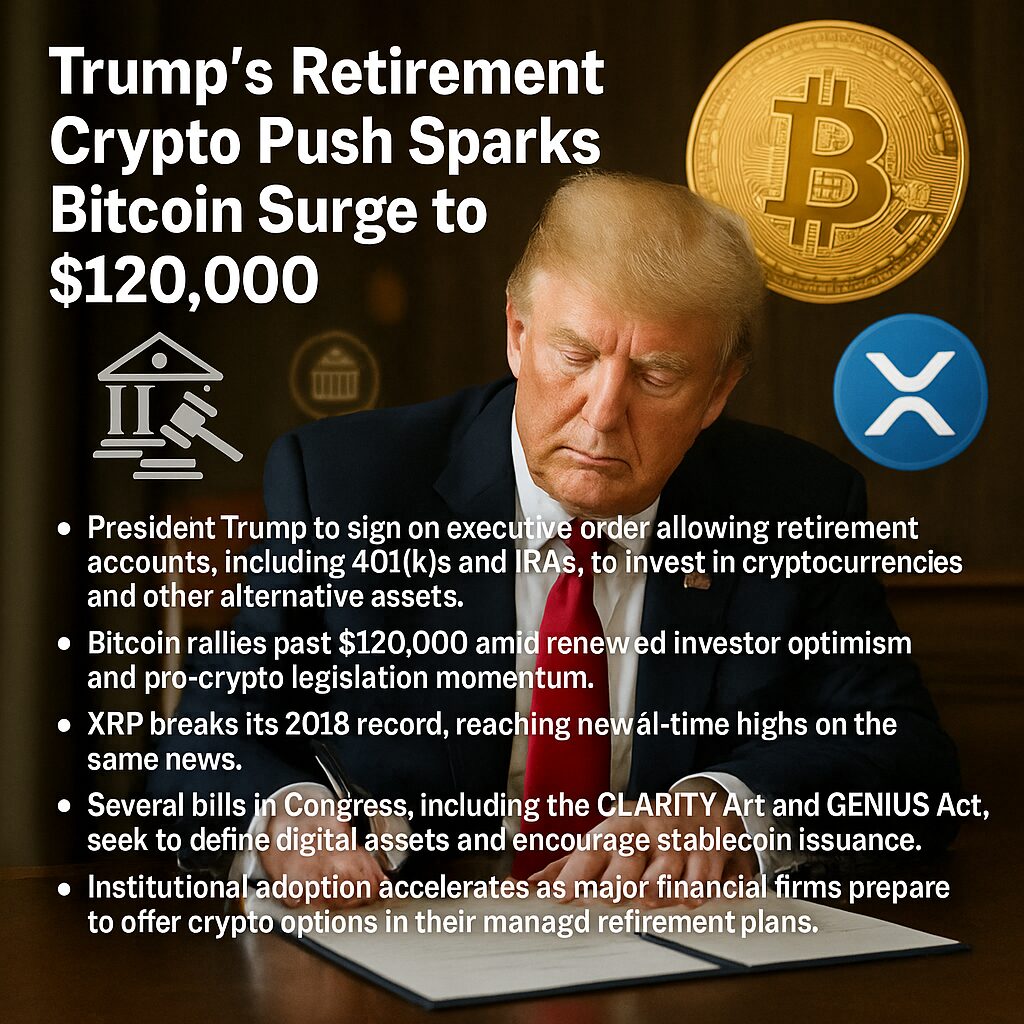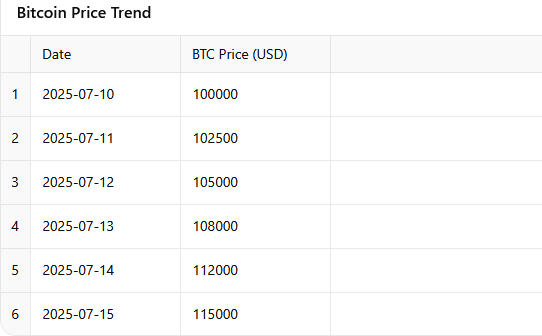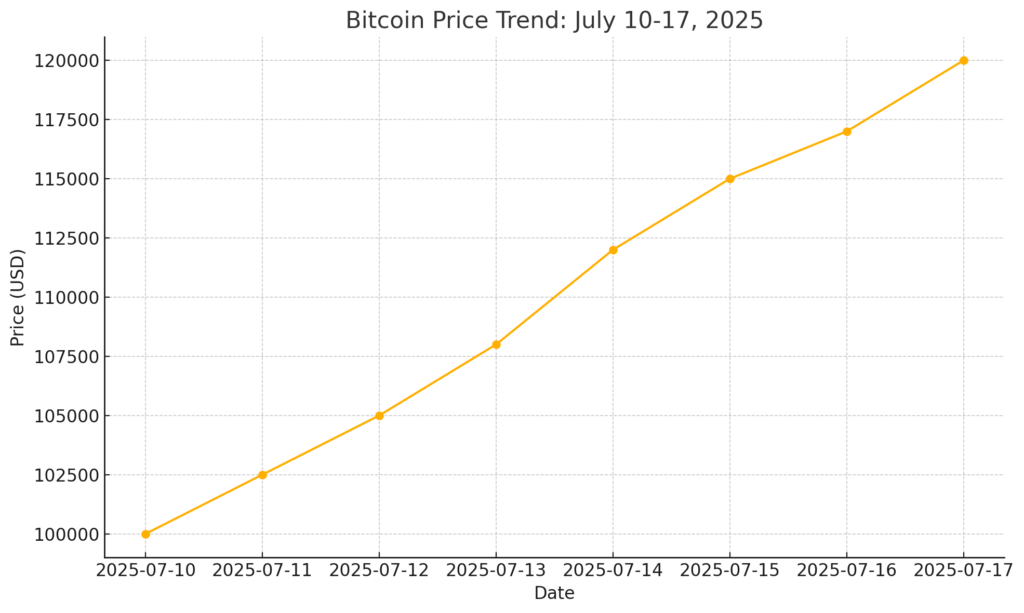
Main Points:
- President Trump to sign an executive order allowing retirement accounts, including 401(k)s and IRAs, to invest in cryptocurrencies and other alternative assets.
- Bitcoin rallies past $120,000 amid renewed investor optimism and pro-crypto legislation momentum.
- XRP breaks its 2018 record, reaching new all-time highs on the same news.
- Several bills in Congress, including the CLARITY Act and GENIUS Act, seek to define digital assets and encourage stablecoin issuance.
- Institutional adoption accelerates as major financial firms prepare to offer crypto options in their managed retirement plans.
- Risks include regulatory uncertainty, potential for higher fees, and market volatility.
1. Executive Order to Expand Retirement Investments
President Donald Trump is set to sign an executive order this week that will allow Americans to include cryptocurrencies, gold, private equity, and infrastructure funds in their retirement accounts, such as 401(k)s and IRAs. Currently, retirement savers primarily invest in mutual funds focused on stocks and bonds. The order directs agencies like the Department of Labor and the Treasury to identify and remove regulatory hurdles preventing alternative asset inclusion.
By expanding the investment menu, Trump aims to position the U.S. retirement market—valued at approximately $9 trillion—as a growth opportunity for digital assets, echoing his administration’s broader pro-crypto stance. His previous actions, such as ending key enforcement measures and supporting crypto-friendly bills in the House, set the stage for this landmark shift.
2. Bitcoin’s Meteoric Rise Past $120,000
Following reports of the impending executive order, Bitcoin (BTC) surged from around $100,000 to over $120,000, a 20% jump in just over a week. The rally reflects both speculative fervor and genuine anticipation that unlocking retirement flows could inject tens of billions of dollars into the crypto market.
Bitcoin Price Trend: July 10–17, 2025 The chart below displays the BTC price movement over the week leading up to the news.

[Bitcoin Price Trend chart]

3. XRP Shatters 2018 Record
Ripple’s XRP also experienced a historic surge, climbing above $3.50 to eclipse its previous all-time high set in early 2018. Investors believe that if retirement accounts can allocate a small percentage to a basket of digital assets, altcoins like XRP will benefit alongside Bitcoin, broadening market depth and liquidity.
4. Congressional “Crypto Week” Legislation
In tandem with executive action, the Republican-controlled House is preparing to debate several key bills during what industry insiders call “Crypto Week.” These include:
- GENIUS Act: Establishes uniform federal standards for payment stablecoins, facilitating their issuance by private entities.
- Digital Asset Market CLARITY Act: Aims to solidify whether tokens fall under the CFTC (commodities) or SEC (securities) jurisdiction, offering much‑needed regulatory certainty.
- Anti‑CBDC Surveillance State Act: Prohibits the Federal Reserve from issuing a central bank digital currency, a favorite among crypto advocates fearing government overreach.
Supporters argue that these measures will catalyze institutional adoption by reducing legal ambiguities; critics warn of unintended consequences and potential loopholes.
5. Institutional Adoption and Market Implications
Major asset managers and retirement-plan administrators—including BlackRock, Vanguard, and Fidelity—are already exploring partnerships to introduce curated crypto funds. If the executive order and legislation come to fruition, these firms could swiftly integrate crypto options into their managed retirement offerings, unlocking new capital channels.
Financial analysts note that adding even 1% of the $9 trillion retirement market to Bitcoin and selected altcoins would represent an inflow of $90 billion—equivalent to over 40% of Bitcoin’s current market capitalization. Such an influx could solidify BTC’s role as “digital gold,” while also exposing it to the dynamics of long-term institutional capital.
6. Potential Risks and Considerations
Despite the excitement, several risks remain:
- Regulatory Uncertainty: Final rules from the Department of Labor and the SEC will shape what assets qualify and under what conditions.
- Cost and Fees: Alternative asset options historically carry higher management fees than traditional mutual funds.
- Volatility: Sudden price swings could adversely affect retirement savers, especially near retirement age.
- Transparency and Custody: Ensuring secure, insured custody solutions and clear reporting standards will be critical to protect savers.
Conclusion
The convergence of executive action and legislative momentum represents a watershed moment for cryptocurrency’s integration into mainstream finance. By potentially unlocking trillions of dollars in retirement savings for digital assets, the U.S. could cement its leadership in blockchain innovation and institutional adoption. However, success will hinge on carefully crafted regulations, robust custodial infrastructure, and transparent fee structures to safeguard the interests of everyday savers. As Bitcoin tops $120,000 and altcoins reach new highs, investors and policymakers alike will watch closely to balance growth opportunities with prudent risk management.

